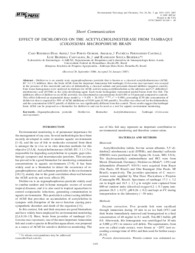Effect of Dichlorvos on the acetylcholinesterase from tambaqui (Colossoma macropomum) Brain.
Effect of Dichlorvos on the acetylcholinesterase from tambaqui (Colossoma macropomum) Brain.
Summary: Dichlorvos is an acutely toxic organophosphorous pesticide that is known as a classical acetylcholinesterase (AChE; EC 3.1.1.7) inhibitor. Here, the brain AChE from the important Amazonian fish tambaqui (Colossoma macropomum) was assayed in the presence of this insecticide and also of deltamethrin, a classical sodium and potassium channel inhibitor (negative control). Four tissue homogenates were analyzed in triplicate for AChE activity using acetylthiocholine as the substrate and 5,5'-dithiobis(2-nitrobenzoic) acid (DTNB) as the color-developing agent. Each tissue homogenate represented pooled brains from five fish. The inhibitory effect of dichlorvos on AChE activities was determined at concentrations from 0.001 to 10 ppm and compared to controls. This effect followed an exponential decay model (y = 9.420 + 26.192e(-x/5.380); r2 = 0.989), presenting IC50 (the concentration of dichlorvos that is required for 50% of AChE inhibition) of 0.081 ppm (0.368 umol/L). No effect was observed for the deltamethrin, and the concentration 0.0452 umol/L of dichlorvos was significantly different from this control. These results suggest that tambaqui brain AChE can be proposed as a biomarker for dichlorvos and can be used as a tool for aquatic environment monitoring.
Publication year: 2007
Types of publication: Journal article
Unit: Embrapa Mid-North
Observation
Some of Embrapa's publications are published as ePub files. To read them, use or download one of the following free software options to your computer or mobile device. Android: Google Play Books; IOS: iBooks; Windows and Linux: Calibre.
Access other publications
Access the Agricultural Research Database (BDPA) to consult Embrapa's full library collection and records.
Visit Embrapa Bookstore to purchase books and other publications sold by Embrapa.

